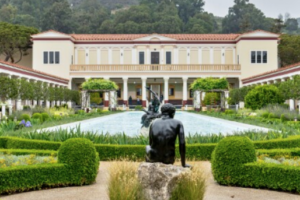As fires raged (and as of this writing, continue to rage) throughout southern California, two world-renown museums—the iconic, large, modern Getty Museum on the edge of northwest Los Angeles and the more intimately designed Getty Villa just outside Malibu—lay directly in the line of fast-moving, out-of-control, uncontained fires. Each houses irreplaceable masterpiece art and historic treasures. 
Of these two Getty museums, the Getty Villa is the more vulnerable to fire damage, although both museums have been built with above-and-beyond, highly sophisticated and state-of-the-art fire protection integrated into every aspect of their structures.
The story below captures the hair-raising, nail-biting, “boots on the ground” reality of how the smaller and more vulnerable Getty Villa saved itself from utter devastation.
More importantly, it demonstrates without words the peerless benefit of thorough disaster planning, preparation and training.
Los Angeles Times—The Getty Villa, the museum built by oil tycoon J. Paul Getty and home to thousands of priceless antiquities, activated its emergency operations center in response to the fast-moving Palisades fire at 10:40 a.m. Tuesday. At 11:44 a.m., fire could be seen over the ridge, less than one mile away. By 12:27, flames had reached the property.
Fast-moving, Unpredictable, Catastrophic in its damage
Fast-moving, wildly unpredictable and catastrophic in the damage it caused along a vast swath of prime coastline, the Palisades fire ultimately spared the Villa and its more than 44,000 objects, including many Roman, Greek and Etruscan relics dating from 6500 BC to AD 400.
J. Paul Getty Trust President and Chief Executive Katherine E. Fleming described for The Times the scene on the ground and how she and her staff worked from a conference center-turned-war room at the Getty Center in Brentwood, about 10 miles away — all while 16 staff members remained at the Villa to implement emergency protocols.
“We did get lucky in some ways, and people were rushing around,” Fleming said in an interview Wednesday evening after the most immediate danger had passed. “But there were also a lot of people who were really thoughtful about this over a long period of time, and I think that clearly paid off for us.”
Extensive brush-clearing over the last year, Fleming said, had been completed with the knowledge that fire is a way of life in Los Angeles, and that the region’s frequent periods of drought made a massively destructive fire inevitable. The museum had already pruned landscaping that might catch fire and made sure tree canopies were high off the ground. Low-lying brush had been significantly thinned. The grounds were irrigated Tuesday morning.
Fleming offered a riveting play-by-play of the day’s events. The staff members who remained at the Villa worked in emergency response, facilities, security and communications — each highly trained in emergency preparations. When the fire broke out, the biggest concern was protecting the collections from the damaging effects of smoke. The double-walled construction of the galleries provided significant protection, and at 10:45 a.m., the dampers — small valves that regulate airflow in a building’s HVAC system — were turned off, as was the air conditioning. The staff still smelled smoke, so the museum doors were sealed at 11:04 a.m. The smoke became overwhelming by 11:15, and at 11:20 the staff was sent an … WORTH THE READ MORE here>>




You must be logged in to post a comment.